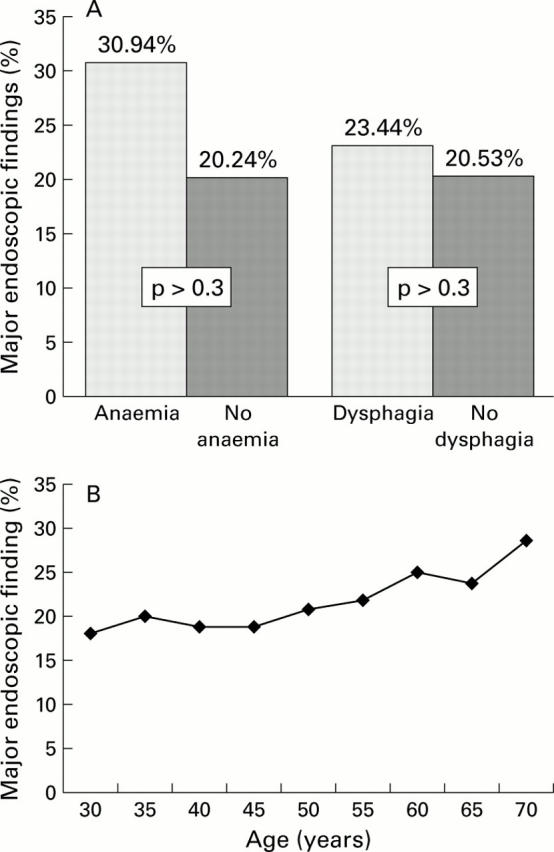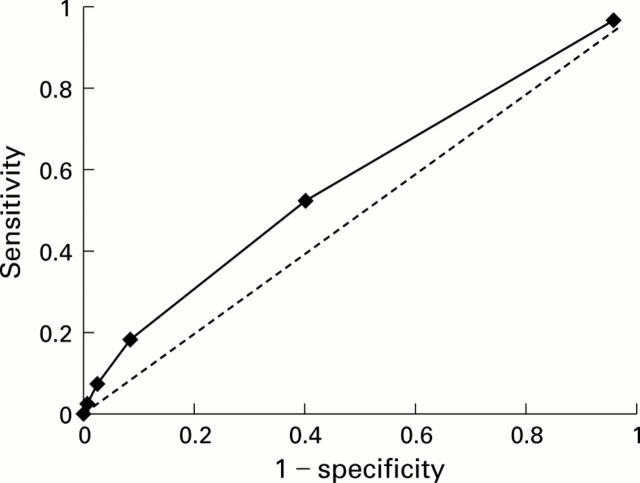Abstract
INTRODUCTION—Symptoms of dyspepsia are common but most patients do not have major upper gastrointestinal pathology. Endoscopy is recommended for dyspeptic patients over the age of 45, or those with certain "alarm" symptoms. We have evaluated the effectiveness of age and "alarm" symptoms for predicting major endoscopic findings in six practising endoscopy centres. METHODS—Clinical variables of consecutive patients with dyspepsia symptoms undergoing upper endoscopy examinations were recorded using a common endoscopy database. Patients who had no previous upper endoscopy or barium radiography were included. Stepwise multivariate logistic regression was used to identify predictors of endoscopic findings. The accuracy of these for predicting endoscopic findings was evaluated with receiver operating characteristic analysis. The sensitivity and specificity of age thresholds from 30 to 70 years were evaluated. RESULTS—Major pathology (tumour, ulcer, or stricture) was found at endoscopy in 787/3815 (21%) patients with dyspepsia. Age, male sex, bleeding, and anaemia were found to be significant but weak independent predictors of endoscopic findings. A multivariate prediction rule based on these factors had poor predictive accuracy (c statistic=0.62). Using a simplified prediction rule of age ⩾45 years or the presence of any "alarm" symptom, sensitivity was 87% and specificity was 26%. Increasing or decreasing the age cut off did not significantly improve the predictive accuracy. CONCLUSIONS—Age and the presence of "alarm" symptoms are not effective predictors of endoscopic findings among patients with dyspepsia. Better clinical prediction strategies are needed to identify patients with significant upper gastrointestinal pathology. Keywords: dyspepsia; endoscopy; age
Full Text
The Full Text of this article is available as a PDF (136.3 KB).
Figure 1 .

(A) Proportion of patients with major endoscopic finding according to the presence or absence of anaemia or dysphagia. (B) By age group.
Figure 2 .
Receiver operating characteristic (ROC) curve showing the relationship between sensitivity and specificity of the prediction rule for major upper gastrointestinal pathology. The diagonal line represents a model which has zero predictive value. C statistic (area under the ROC curve)=0.62
Selected References
These references are in PubMed. This may not be the complete list of references from this article.
- Adang R. P., Vismans J. F., Talmon J. L., Hasman A., Ambergen A. W., Stockbrügger R. W. Appropriateness of indications for diagnostic upper gastrointestinal endoscopy: association with relevant endoscopic disease. Gastrointest Endosc. 1995 Nov;42(5):390–397. doi: 10.1016/s0016-5107(95)70037-4. [DOI] [PubMed] [Google Scholar]
- Asante M. A., Mendall M., Patel P., Ballam L., Northfield T. C. A randomized trial of endoscopy vs no endoscopy in the management of seronegative Helicobacter pylori dyspepsia. Eur J Gastroenterol Hepatol. 1998 Dec;10(12):983–989. doi: 10.1097/00042737-199812000-00001. [DOI] [PubMed] [Google Scholar]
- Beck J. R., Shultz E. K. The use of relative operating characteristic (ROC) curves in test performance evaluation. Arch Pathol Lab Med. 1986 Jan;110(1):13–20. [PubMed] [Google Scholar]
- Bytzer P., Hansen J. M., Schaffalitzky de Muckadell O. B. Empirical H2-blocker therapy or prompt endoscopy in management of dyspepsia. Lancet. 1994 Apr 2;343(8901):811–816. doi: 10.1016/s0140-6736(94)92023-0. [DOI] [PubMed] [Google Scholar]
- Bytzer P., Schaffalitzky de Muckadell O. B. Prediction of major pathologic conditions in dyspeptic patients referred for endoscopy. A prospective validation study of a scoring system. Scand J Gastroenterol. 1992 Nov;27(11):987–992. doi: 10.3109/00365529209000176. [DOI] [PubMed] [Google Scholar]
- Christie J., Shepherd N. A., Codling B. W., Valori R. M. Gastric cancer below the age of 55: implications for screening patients with uncomplicated dyspepsia. Gut. 1997 Oct;41(4):513–517. doi: 10.1136/gut.41.4.513. [DOI] [PMC free article] [PubMed] [Google Scholar]
- Drossman D. A., Li Z., Andruzzi E., Temple R. D., Talley N. J., Thompson W. G., Whitehead W. E., Janssens J., Funch-Jensen P., Corazziari E. U.S. householder survey of functional gastrointestinal disorders. Prevalence, sociodemography, and health impact. Dig Dis Sci. 1993 Sep;38(9):1569–1580. doi: 10.1007/BF01303162. [DOI] [PubMed] [Google Scholar]
- Ebell M. H., Warbasse L., Brenner C. Evaluation of the dyspeptic patient: a cost-utility study. J Fam Pract. 1997 Jun;44(6):545–555. [PubMed] [Google Scholar]
- Edenholm M., Gustavsson R., Jansson O., Lingfors H., Nilsson O., Söderlind T., Titusson L., Thulin A. Endoscopic findings in patients with ulcer-like dyspepsia. Scand J Gastroenterol Suppl. 1985;109:163–167. doi: 10.3109/00365528509103953. [DOI] [PubMed] [Google Scholar]
- Gear M. W., Barnes R. J. Endoscopic studies of dyspepsia in a general practice. Br Med J. 1980 May 3;280(6223):1136–1137. doi: 10.1136/bmj.280.6223.1136. [DOI] [PMC free article] [PubMed] [Google Scholar]
- Gillen D., McColl K. E. Does concern about missing malignancy justify endoscopy in uncomplicated dyspepsia in patients aged less than 55? Am J Gastroenterol. 1999 Jan;94(1):75–79. doi: 10.1111/j.1572-0241.1999.00774.x. [DOI] [PubMed] [Google Scholar]
- Heaney A., Collins J. S., Tham T. C., Watson P. R., McFarland J. R., Bamford K. B. A prospective study of the management of the young Helicobacter pylori negative dyspeptic patient--can gastroscopies be saved in clinical practice? Eur J Gastroenterol Hepatol. 1998 Nov;10(11):953–956. doi: 10.1097/00042737-199811000-00009. [DOI] [PubMed] [Google Scholar]
- Holtmann G., Goebell H., Holtmann M., Talley N. J. Dyspepsia in healthy blood donors. Pattern of symptoms and association with Helicobacter pylori. Dig Dis Sci. 1994 May;39(5):1090–1098. doi: 10.1007/BF02087563. [DOI] [PubMed] [Google Scholar]
- Johnsen R., Bernersen B., Straume B., Førde O. H., Bostad L., Burhol P. G. Prevalences of endoscopic and histological findings in subjects with and without dyspepsia. BMJ. 1991 Mar 30;302(6779):749–752. doi: 10.1136/bmj.302.6779.749. [DOI] [PMC free article] [PubMed] [Google Scholar]
- Kagevi I., Löfstedt S., Persson L. G. Endoscopic findings and diagnoses in unselected dyspeptic patients at a primary health care center. Scand J Gastroenterol. 1989 Mar;24(2):145–150. doi: 10.3109/00365528909093029. [DOI] [PubMed] [Google Scholar]
- Kuykendall D. H., Rabeneck L., Campbell C. J., Wray N. P. Dyspepsia: how should we measure it? J Clin Epidemiol. 1998 Feb;51(2):99–106. doi: 10.1016/s0895-4356(97)00245-x. [DOI] [PubMed] [Google Scholar]
- Laheij R. J., Severens J. L., Van de Lisdonk E. H., Verbeek A. L., Jansen J. B. Randomized controlled trial of omeprazole or endoscopy in patients with persistent dyspepsia: a cost-effectiveness analysis. Aliment Pharmacol Ther. 1998 Dec;12(12):1249–1256. doi: 10.1046/j.1365-2036.1998.00423.x. [DOI] [PubMed] [Google Scholar]
- Locke G. R., 3rd, Talley N. J., Fett S. L., Zinsmeister A. R., Melton L. J., 3rd Prevalence and clinical spectrum of gastroesophageal reflux: a population-based study in Olmsted County, Minnesota. Gastroenterology. 1997 May;112(5):1448–1456. doi: 10.1016/s0016-5085(97)70025-8. [DOI] [PubMed] [Google Scholar]
- Mansi C., Savarino V., Mela G. S., Picciotto A., Mele M. R., Celle G. Are clinical patterns of dyspepsia a valid guideline for appropriate use of endoscopy? A report on 2253 dyspeptic patients. Am J Gastroenterol. 1993 Jul;88(7):1011–1015. [PubMed] [Google Scholar]
- Rabeneck L., Wray N. P., Graham D. Y. Managing dyspepsia: what do we know and what do we need to know? Am J Gastroenterol. 1998 Jun;93(6):920–924. doi: 10.1111/j.1572-0241.1998.277_e.x. [DOI] [PubMed] [Google Scholar]
- Silverstein M. D., Petterson T., Talley N. J. Initial endoscopy or empirical therapy with or without testing for Helicobacter pylori for dyspepsia: a decision analysis. Gastroenterology. 1996 Jan;110(1):72–83. doi: 10.1053/gast.1996.v110.pm8536890. [DOI] [PubMed] [Google Scholar]
- Sonnenberg A. Cost-benefit analysis of testing for Helicobacter pylori in dyspeptic subjects. Am J Gastroenterol. 1996 Sep;91(9):1773–1777. [PubMed] [Google Scholar]
- Talley N. J., McNeil D., Piper D. W. Discriminant value of dyspeptic symptoms: a study of the clinical presentation of 221 patients with dyspepsia of unknown cause, peptic ulceration, and cholelithiasis. Gut. 1987 Jan;28(1):40–46. doi: 10.1136/gut.28.1.40. [DOI] [PMC free article] [PubMed] [Google Scholar]
- Talley N. J., Weaver A. L., Tesmer D. L., Zinsmeister A. R. Lack of discriminant value of dyspepsia subgroups in patients referred for upper endoscopy. Gastroenterology. 1993 Nov;105(5):1378–1386. doi: 10.1016/0016-5085(93)90142-y. [DOI] [PubMed] [Google Scholar]
- Talley N. J., Zinsmeister A. R., Schleck C. D., Melton L. J., 3rd Dyspepsia and dyspepsia subgroups: a population-based study. Gastroenterology. 1992 Apr;102(4 Pt 1):1259–1268. [PubMed] [Google Scholar]
- Wiklund I., Glise H., Jerndal P., Carlsson J., Talley N. J. Does endoscopy have a positive impact on quality of life in dyspepsia? Gastrointest Endosc. 1998 Jun;47(6):449–454. doi: 10.1016/s0016-5107(98)70243-3. [DOI] [PubMed] [Google Scholar]
- Williams B., Luckas M., Ellingham J. H., Dain A., Wicks A. C. Do young patients with dyspepsia need investigation? Lancet. 1988 Dec 10;2(8624):1349–1351. doi: 10.1016/s0140-6736(88)90879-3. [DOI] [PubMed] [Google Scholar]



